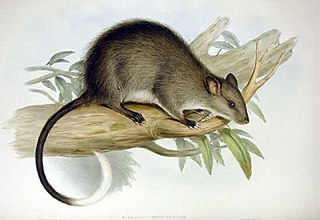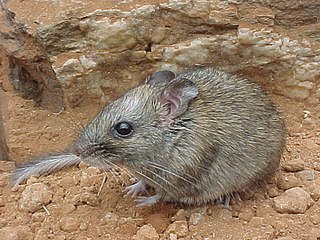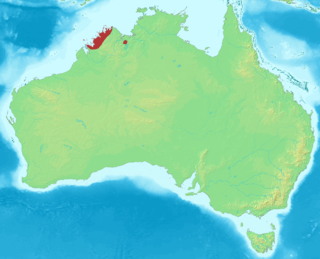 W
WThe Australian swamp rat, also known as the eastern swamp rat, is a species of rat native to the coasts of southern and eastern Australia.
 W
WThe black-footed tree-rat also known as Djintamoonga is one of two endemic arboreal rat species from the genus Mesembriomys found in the northern regions of Australia.
 W
WBolam's mouse is a species of nocturnal, burrowing rodent in the family Muridae that inhabits the semi arid and southern arid regions of Australia. It has a number of physiological and behavioural adaptations developed to cope with an extremely varied climate. Including the ability survive by extracting water from seeds alone, the production of highly concentrated urine, low water content faeces and nocturnal activity.
 W
WThe Bramble Cay melomys, or Bramble Cay mosaic-tailed rat, is a recently extinct species of rodent in the family Muridae and subfamily Murinae. It was an endemic species of the isolated Bramble Cay, a vegetated coral cay located at the northern tip of the Great Barrier Reef in Australia. Described by researchers as having last been seen in 2009 and declared extinct by the Queensland Government and University of Queensland researchers in 2016, it was formally declared extinct by the International Union for Conservation of Nature (IUCN) in May 2015 and the Australian government in February 2019. Having been the only mammal endemic to the reef, its extinction was described as the first extinction of a mammal species due to anthropogenic climate change.
 W
WThe broad-toothed rat is a species of rodent in the family Muridae.
 W
WThe brush-tailed rabbit rat is a species of rodent in the family Muridae. It is found in Australia and Papua New Guinea.
 W
WThe bush rat or Australian bush rat is a small Australian nocturnal animal. It is an omnivore and one of the most common indigenous species of rat on the continent, found in many heathland areas of Victoria and New South Wales.
 W
WThe central rock rat, also known as the central thick-tailed rock-rat, Macdonnell Range rock-rat, Australian native mouse, rat à grosse queue (French), or rata coligorda (Spanish), is a species of rodent in the family Muridae that is found only in Australia. The rats have been found in rocky outcrops and on mountainsides with loose stones, as well as hilly grasslands and low open shrubland or woodland. Historically, Z. pedunculatus is only known to be found in a 77 km length of the West MacDonnell Ranges, Northern Territory. The species has previously been recorded from living animals or cave deposits in Northern Territory at Uluru-Kata Tjuta National Park, Illamurta, Haast's Bluff, Mount Liebig, Napperby Station, Devils Marbles, The Granites, and the Davenport Range. It is known from cave deposits in the Cape Range, Western Australia.
 W
WThe desert mouse, also known as the brown desert mouse, is a species of rodent in the family Muridae. It is endemic to Australia. The first desert mouse specimen was collected by Australian zoologist Gerard Krefft on the Blandowski Expedition in 1856-57, between Gol Gol Creek and the Darling River.
 W
WThe eastern chestnut mouse is a species of rodent in the family Muridae. It is found only in Australia, along the eastern coast from northern Queensland and into New South Wales as far as Jervis Bay.
 W
WThe false water rat is a species of rodent native to waterways of Australia and Papua New Guinea.
 W
WThe fawn hopping mouse is a rodent native to the central Australian desert. Like all hopping mice it has strong front teeth, a long tail, dark eyes, big ears, well-developed haunches and very long, narrow hind feet. It weighs between 30 and 50 g.
 W
WThe fawn-footed mosaic-tailed rat, or fawn-footed melomys is a species of rodent in the family Muridae. It is found only in Australia.
 W
WThe golden-backed tree rat is a species of rodent in the family Muridae. It is found only in Australia.
 W
WGould's mouse lived in eastern inland Australia, and was named after John Gould. It was slightly smaller than a black rat, and quite social, living in small family groups that sheltered by day in a nest of soft, dry grass in a burrow. It usually dug burrows at a depth of 15 cm under bushes. Gould's mouse was common and widespread before European settlement, but disappeared rapidly after the 1840s, perhaps being exterminated by cats. Alternatively, it may have been out-competed by the introduced rats and mice, succumbed to introduced diseases or been affected by grazing stock and changed fire regimes. Despite extensive survey work in its known range, the last specimens were collected in 1856–57, and it is presumed to be extinct.
 W
WThe greater stick-nest rat, also known as the house-building rat and wopilkara is a species of rodent in the family Muridae. They are about the size of a small rabbit and construct large nests of interwoven sticks. Once widespread across southern Australia, the population was reduced after colonisation to one island; the species has been reintroduced to protected and monitored areas.
 W
WThe Hastings River mouse is a species of Australian rodent in the subfamily Murinae of the family Muridae. It is found only in Australia.
 W
WThe Kimberley rock rat is a species of rodent in the family Muridae. It is found only in Australia. It is specifically found in northern tropical part of the northern territory and adjacent Kimberley division of west Australia in high altitude closed forest. Biologist predicted that Zyzomys woodwardi speciated from Zyzomys argurus around 8000 years ago due to a large flood that increased the wetness of the environment. In response to the wetter environment Zyzomys woodwardi had a better Darwinian fitness and outcompeted Zyzomys argurus due to new selective pressures and over time the two species were separated by large vine thickets and sandstone barriers.
 W
WThe lesser stick-nest rat or white-tipped stick-nest rat is an extinct species of rodent in the family Muridae. It lived in central Australia where it built nests of sticks that accumulate over years and can become very large. The last confirmed sighting of this rat was in 1933 although there is a credible report of a sighting in 1970. In 2008, the International Union for Conservation of Nature listed it as "critically endangered", suggesting that it may yet survive in remote areas of unsurveyed territory, but revised its evaluation to "extinct" again in 2016, based on an assessment in 2012.
 W
WThe little native mouse, also known as the delicate mouse, is a species of rodent in the family Muridae. Kunwinjku of western Arnhem Land call this little creature Kijbuk.
 W
WThe long-haired rat, is a species of rodent in the family Muridae which is native to Australia. The long-haired rat is well known for its population eruptions over vast areas of Australia which is the basis of its alternative common name, the plague rat. Most of the research on the long-haired rat has been conducted during times of massive population fluctuations and therefore little is known about their biology in a non-eruptive period.
 W
WThe long-tailed hopping mouse is an extinct species of rodent in the family Muridae. It was found only in Australia. It is known from a handful of specimens, the last of which was collected in 1901 or possibly 1902. It is presumed to have become extinct within a few decades from then – possibly several decades in view of a skull fragment found in an owl pellet in 1977. The cause of extinction is unknown, but may be a variety of factors including predation and habitat alteration. Little is known of its biology other than that it dug burrows in stiff clay soils. It was less a pest to humans than other hopping mice, although it would eat raisins. The mouse was mainly gray in colour with small pink ears and big eyes with a long hairy pink tail about two inches longer than its own body. It was first described by John Gould on the basis of specimens sent to him from Australia.
 W
WMitchell's hopping mouse is the largest extant member of the genus Notomys, weighing between 40 and 60 g. N. mitchellii is a bipedal rodent with large back legs, similar to a jerboa or kangaroo rat. The species occurs throughout much of semi-arid Southern Australia, and appears to be particularly common on the Eyre Peninsula, South Australia. Typical habitat for N. mitchellii appears to be mallee shrublands on sandy dune systems. The species is currently considered to be unthreatened, but its range has been reduced through habitat disturbance and destruction associated with European settlement in Australia.
 W
WThe New Holland mouse is a species of rodent in the family Muridae. It was first described by George Waterhouse in 1843. It vanished from view for over a century before its rediscovery in Ku-ring-gai Chase National Park north of Sydney in 1967. It is found only in south east Australia, within the states of New South Wales, Queensland, Victoria, and Tasmania.
 W
WPseudomys pilligaensis, commonly known as the Pilliga mouse or poolkoo, is a species of rodent in the family Muridae. Its distribution comprises the Pilliga forest region of New South Wales, Australia, specimens have also been trapped in the Warrumbungle National Park and Weetalibah Nature Reserve. Its conservation status is currently listed as "Data Deficient" due to unresolved questions on its taxonomic status.
 W
WThe plains rat (Pseudomys australis), also known as the plains mouse, is a conilurine rodent native to arid and semi-arid Australia. Referred to as the pallyoora or yarlie by Indigenous groups, the plains rat was once widely distributed across central Australia, including north-west New South Wales and south-west Queensland; however, habitat degradation due to grazing, introduced predators and drought have contributed to its decline. Consequently, the plains rat has been listed as 'presumed extinct' in New South Wales and Victoria, 'endangered' in the Northern Territory and Queensland and 'vulnerable' in Western Australia and South Australia. While recent research has indicated the presence of the plains rat in areas such as the Fowlers Gap and Strzelecki Desert regions of New South Wales and within the Diamantina National Park in Queensland, there are only five sub-populations currently recognised nationally, none of which coincide with recent discoveries of the plains rat. As the current population trend of the plains rat has been listed as 'declining' by the International Union for the Conservation of Nature (IUCN), the IUCN conservation status for the species is 'vulnerable'.
 W
WThe rakali, Hydromys chrysogaster, also known as the rabe or water-rat, is an Australian native rodent first described in 1804. The change to the aboriginal name Rakali was intended to foster a positive public attitude by Environment Australia. The Gunwinggu (Kunwinjku) people of western Arnhem Land call this animal Yirrku.
 W
WThe sandy inland mouse is a species of rodent in the family Muridae. Also known as the Hermannsburg (Mission) false-mouse or Hermannsburg Mouse, it is endemic to Australia and found widely yet sparsely through arid and semi-arid areas.
 W
WThe spinifex hopping mouse, also known as the tarkawara or tarrkawarra, occurs throughout the central and western Australian arid zones, occupying both spinifex-covered sand flats and stabilised sand dunes, and loamy mulga and melaleuca flats.
 W
WThe northern palm squirrel also called the five-striped palm squirrel is a species of rodent in the family Sciuridae. Some authorities recognise two subspecies, F. p. pennantii and F. p. argentescens. It is a semi-arboreal species found in tropical and subtropical dry deciduous forest and many other rural and urban habitats. It is a common species with a wide range and the International Union for Conservation of Nature has rated its conservation status as being of "least concern".
 W
WThe western mouse or walyadji refers to Pseudomys occidentalis, a species of rodent in the family Muridae. Once widespread across a larger range, it has become restricted to around ten reserves of remnant bushland in Southwest Australia and declared near threatened by extinction. They are small and robust mice that live in burrows in sandy soil, venturing out at night to forage in nearby area.
 W
WThe white-footed rabbit-rat is an extinct species of rodent, which was originally found in woodlands from Adelaide to Sydney, but became restricted to south-eastern Australia. It was kitten-sized and was one of Australia's largest native rodents. It was nocturnal and lived among trees. It made nests filled with leaves and possibly grass in the limbs of hollow eucalyptus trees. The mother carried her young attached to her teats. In a letter to John Gould, then Governor of South Australia Sir George Grey said that he removed a baby from a teat of its dead mother. The baby clung tightly to Gould's glove.